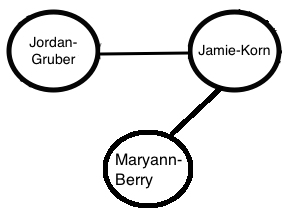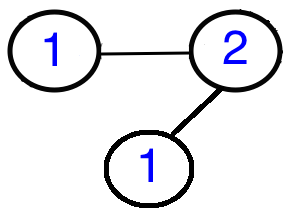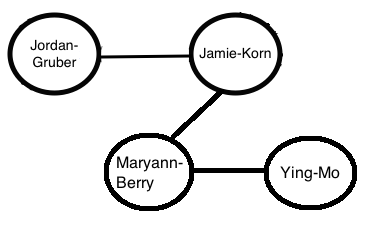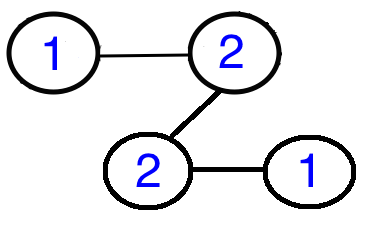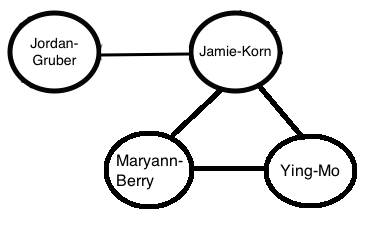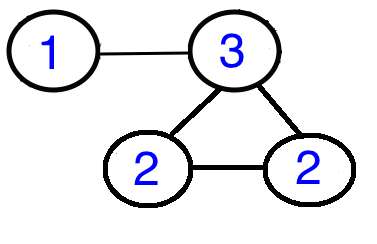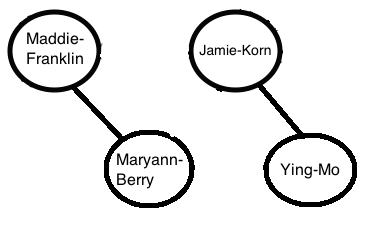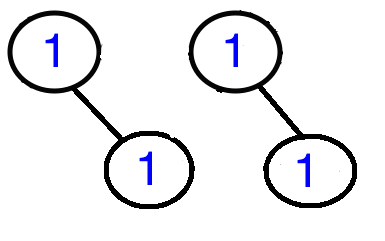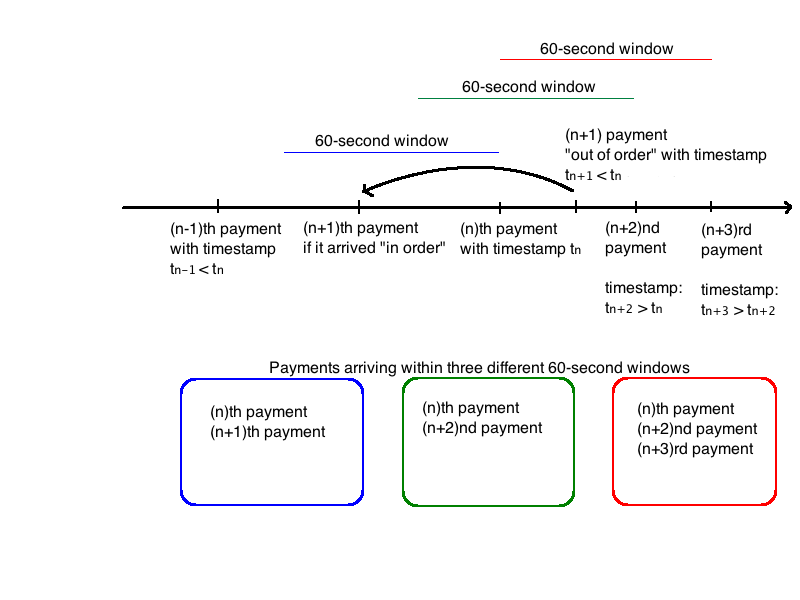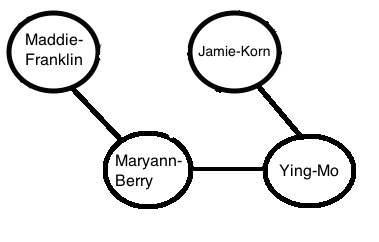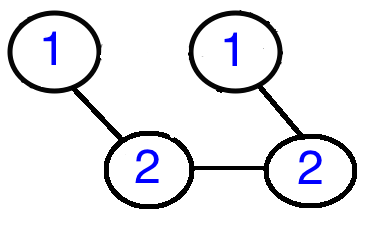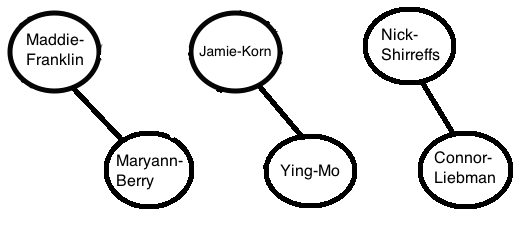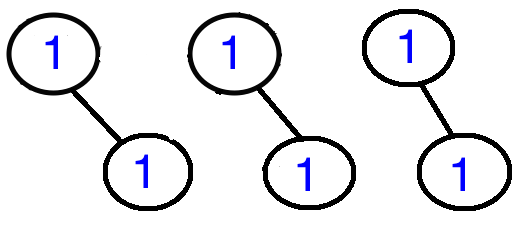This is an unfinished attempt at the Data Engineering Code Challenge. I used the Python software package Networkx (https://networkx.github.io/) for storing the Venmo transaction network graph.
Afer my day job, I enjoyed hacking at the well-written code challenge and finally having a change to build a network graph. It was refreshing to write in Python because the language is so expressive -- perfect for building up every node of the data pipeline. Developing this Code Challenge at night made me realize that I really miss the type of problem solving in data engineering.
- [Challenge Summary] (README.md#challenge-summary)
- [Details of Implementation] (README.md#details-of-implementation)
- [Building the Venmo Graph] (README.md#building-the-venmo-graph)
- [Maintain data within the 60 second window] (README.md#maintain-data-within-the-60-second-window)
- [Dealing with payments that arrive out of time] (README.md#dealing-with-payments-that-arrive-out-of-time)
- [Collecting payments from Venmo API] (README.md#collecting-payments-from-venmo-api)
- [Writing clean, scalable, and well-tested code] (README.md#writing-clean-scalable-and-well-tested-code)
- [Repo directory structure] (README.md#repo-directory-structure)
- [Testing your directory structure and output format] (README.md#testing-your-directory-structure-and-output-format)
- [FAQ] (README.md#faq)
For this coding challenge, you will develop tools that could help analyze Venmo’s dataset. Some of the challenges here mimic real world problems.
##Challenge Summary
[Back to Table of Contents] (README.md#table-of-contents)
This challenge requires you to:
-
Use Venmo payments that stream in to build a graph of users and their relationship with one another.
-
Calculate the median degree of a vertex in a graph and update this each time a new Venmo payment appears. You will be calculating the median degree across a 60-second sliding window.
The vertices on the graph represent Venmo users and whenever one user pays another user, an edge is formed between the two users.
##Details of implementation
[Back to Table of Contents] (README.md#table-of-contents)
We'd like you to implement your own version of this. However, we don't want this challenge to focus on the relatively uninteresting "DevOps" of connecting to the Venmo API. Normally, payments can be obtained through Venmo’s API, but you may assume this has already been done, and data has been written to a file named venmo-trans.txt in a directory called venmo_input.
This file venmo-trans.txt will contain the actual JSON messages with each payment on a newline:
venmo-trans.txt:
{JSON of first payment}
{JSON of second payment}
{JSON of third payment}
.
.
.
{JSON of last payment}
One example of the data for a single Venmo payment might look like:
{"created_time": "2014-03-27T04:28:20Z", "target": "Jamie-Korn", "actor": "Jordan-Gruber"}
You will update the graph and its associated median degree each time you process a new payment. The graph should only consist of payments with timestamps that are 60 seconds or less from the maximum timestamp that has been processed.
As new payments come in, edges that were formed between users with payments older than 60 seconds from the maximum timestamp should be evicted. For each incoming payment, extract the specified following fields from the JSON response:
actor
target
created_time
The created_time field can be used in lieu of a timestamp.
##Building the Venmo Graph [Back to Table of Contents] (README.md#table-of-contents)
Here is an example of the extracted information from eight payments:
actor = Jordan-Gruber, target = Jamie-Korn, created_time: 2016-04-07T03:33:19Z
actor = Maryann-Berry, target = Jamie-Korn, created_time: 2016-04-07T03:33:19Z
actor = Ying-Mo, target = Maryann-Berry, created_time: 2016-04-07T03:33:19Z
actor = Jamie-Korn, target = Ying-Mo, created_time: 2016-04-07T03:34:18Z
actor = Maryann-Berry, target = Maddie-Franklin, created_time: 2016-04-07T03:34:58Z
actor = Maryann-Berry, target = Ying-Mo, created_time: 2016-04-07T03:34:00Z
actor = Natalie-Piserchio, target = Rebecca-Waychunas, created_time: 2016-04-07T03:31:18Z
actor = Nick-Shirreffs, target = Connor-Liebman, created_time: 2016-04-07T03:35:02Z
Two users will be connected if they are present in a payment.
NOTE: The order of the payments coming in might not be ordered by time (we'll see an example below on how to deal with payments that are out of order in time), which mimics what one would get from a streaming API.
A good way to create this graph is with an edge list where an edge is defined by two users who are involved in a payment transaction.
In this case, the first payment that enters the system has a timestamp of 2016-04-07T03:33:19Z and the edge formed is
Jordan-Gruber <-> Jamie-Korn
The degree of each node is defined as the number of connected neighboring nodes. The median degree is the middle value of all of the degrees in the graph.
In this case, the median degree is calculated from this set of values: {1, 1}
Therefore, the rolling median degree output is
1.00
The second payment that arrives is in order and forms new edges in the graph.
Jordan-Gruber <-> Jamie-Korn
Maryann-Berry <-> Jamie-Korn
The graph now has three nodes and two edges
Median Degree of {1, 1, 2} = 1.00
The rolling median degree output is
1.00
1.00
With the third payment coming in, these edges are formed:
Jordan-Gruber <-> Jamie-Korn
Maryann-Berry <-> Jamie-Korn
Ying-Mo <-> Maryann-Berry
The graph now has four nodes and three edges:
The degrees are {1, 1, 2, 2} and the median is the average of the two middle values, 1 and 2 -- or 1.50.
The rolling median degree output now becomes:
1.00
1.00
1.50
The fourth payment that comes also is in order of time and forms new edges. The edges in the graph are:
Jordan-Gruber <-> Jamie-Korn
Maryann-Berry <-> Jamie-Korn
Ying-Mo <-> Maryann-Berry
Jamie-Korn <-> Ying-Mo
The fourth payment adds no new nodes but increases the edges, and therefore, degrees on some of the nodes.
The set of degrees becomes {1, 2, 2, 3}, making the median 2.00
The rolling median degree output at the end of fourth payment is
1.00
1.00
1.50
2.00
Note that all the payments arrive in a timely order in this example, and for every incoming payment, all the old payments sit within the 60 second window from the timestamp of the latest incoming payment. Hence, no payments are evicted (we'll see an example below on how the edge eviction should be handled with time).
##Maintain data within the 60-second window [Back to Table of Contents] (README.md#table-of-contents)
Now let's say that the next payment comes in and the extracted information is
actor = Maryann-Berry, target = Maddie-Franklin, created_time: 2016-04-07T03:34:58Z
Extracted information from the five payments is
actor = Jordan-Gruber, target = Jamie-Korn, created_time: 2016-04-07T03:33:19Z
actor = Maryann-Berry, target = Jamie-Korn, created_time: 2016-04-07T03:33:19Z
actor = Ying-Mo, target = Maryann Berry, created_time: 2016-04-07T03:33:19Z
actor = Jamie-Korn, target = Ying-Mo, created_time: 2016-04-07T03:34:18Z
actor = Maryann-Berry, target = Maddie-Franklin, created_time: 2016-04-07T03:34:58Z
We can see that the first three payments have a timestamp that is more than 60 seconds older than this new payment. This means that the edges formed by the three payments should be evicted and should not be included in our median degree calculation.
The revised information to be used in constructing the graph is as follows:
actor = Jamie-Korn, target = Ying-Mo, created_time: 2016-04-07T03:34:18Z
actor = Maryann-Berry, target = Maddie-Franklin, created_time: 2016-04-07T03:34:58Z
The edge list is now:
Jamie-Korn <-> Ying-Mo
Maryann-Berry <-> Maddie-Franklin
The graph has now changed to:
The rolling median degree, recalculated from {1, 1, 1, 1}, = 1.00
Normally, the median degree is calculated for a single graph, but maintaining multiple graphs for this problem can be quite difficult. For simplicity, we are only interested in calculating the median degree of all the nodes in all graphs despite them being disconnected.
The list of rolling median degrees now becomes:
1.00
1.00
1.50
2.00
1.00
##Dealing with payments that arrive out of time [Back to Table of Contents] (README.md#table-of-contents)
Payments that are out of order and fall within the 60 second window of the maximum timestamp processed, or in other words, are less than 60 seconds from the maximum timestamp being processed, will create new edges in the graph.
However, payments that are out of order in time and outside the 60-second window (or more than 60 seconds from the maximum timestamp being processed) should be ignored. Such payments won't contribute to building the graph. Below is a diagram showing this situation, with the nth payment corresponding the payment on the nth line of the venmo-trans.txt file.
Continuing our example, another new payment comes in with the following extracted information:
actor = Maryann-Berry, target = Ying-Mo, created_time: 2016-04-07T03:34:00Z
This payment is out of order but its timestamp still falls within the 60-second time window of the maximum timestamp that has been processed. (i.e., 2016-04-07T03:34:58Z)
So the edge list is now
actor = Jamie-Korn, target = Ying-Mo, created_time: 2016-04-07T03:34:18Z
actor = Maryann-Berry, target = Maddie-Franklin, created_time: 2016-04-07T03:34:58Z
actor = Maryann-Berry, target = Ying-Mo, created_time: 2016-04-07T03:34:00Z
The median degree now calculated from {1, 1, 2, 2} = 1.50. The list of rolling median degrees becomes:
1.00
1.00
1.50
2.00
1.00
1.50
Another payment now arrives
actor = Natalie-Piserchio, target = Rebecca-Waychunas, created_time: 2016-04-07T03:31:18Z
But this payment is out of order and its timestamp is outside of the maximum timestamp last processed (i.e., 2016-04-07T03:34:58Z). This payment should be ignored. It will not form any new edges and will not contribute to the graph. The graph remains the same as before this payment arrived.
The rolling median is the same as before: {1, 1, 2, 2} = 1.50.
1.00
1.00
1.50
2.00
1.00
1.50
1.50
Finally, another payment arrives with this information:
actor = Nick-Shirreffs, target = Connor-Liebman, created_time: 2016-04-07T03:35:02Z
Because this payment now has the latest timestamp of 2016-04-07T03:35:02Z, we must add it to our graph while pruning the nodes and edges that fall outside of the 60-second-window (i.e., edge between Maryann-Berry and Ying-Mo must be removed)
The payments now represented in the graph are:
actor = Jamie-Korn, target = Ying-Mo, created_time: 2016-04-07T03:34:18Z
actor = Maryann-Berry, target = Maddie-Franklin, created_time: 2016-04-07T03:34:58Z
actor = Nick-Shirreffs, target = Connor-Liebman, created_time: 2016-04-07T03:35:02Z
The new median degree, calculated from {1, 1, 1, 1, 1, 1} = 1.00 and our new list of rolling medians is
1.00
1.00
1.50
2.00
1.00
1.50
1.50
1.00
The output should be a file in the venmo_output directory named output.txt that contains the rolling median for each transaction in the file (e.g. if there are three input transactions, then there should be 3 medians), following the format above. The precision of the average should be two digits after the decimal place with truncation.
##Collecting payments from Venmo API
[Back to Table of Contents] (README.md#table-of-contents)
Ideally, the updates to the median degree of the graph would be connected to the Venmo streaming API and would add new payment to the end of venmo-trans.txt. However, connecting to the API has been discontinued for new users, and even if it were possible, would require more system specific "DevOps" work, which isn't the primary focus for data engineers.
Instead, you should simply assume that each new line of the text file corresponds to a new Venmo payment and design your program to handle a text file with a large number of payments. Your program should output the results to a text file named output.txt in the venmo_output directory.
##Writing clean, scalable and well-tested code [Back to Table of Contents] (README.md#table-of-contents)
As a data engineer, it’s important that you write clean, well-documented code that scales for large amounts of data. For this reason, it’s important to ensure that your solution works well for a huge number of payments, rather than just the simple examples above.
For example, your solution should be able to account for a large number of payments coming in a short period of time, and need to keep up with the input (i.e. need to process a minute of payments in less than a minute).
It's also important to use software engineering best practices like unit tests, especially since public data is not clean and predictable.
You may write your solution in any mainstream programming language such as C, C++, C#, Clojure, Erlang, Go, Haskell, Java, Python, Ruby, or Scala. Once completed, submit a link to a Github repo with your source code.
In addition to the source code, the top-most directory of your repo must include the venmo_input and venmo_output directories, and a shell script named run.sh that compiles and runs the program(s) that implement these features.
If your solution requires additional libraries, environments, or dependencies, you must specify these in your README documentation. See the figure below for the required structure of the top-most directory in your repo, or simply clone this repo.
##Repo directory structure [Back to Table of Contents] (README.md#table-of-contents)
Example Repo Structure
├── README.md
├── run.sh
├── src
│ └── median_degree.java
├── venmo_input
│ └── venmo-trans.txt
├── venmo_output
│ └── output.txt
└── insight_testsuite
├── run_tests.sh
└── tests
└── test-1-venmo-trans
│ ├── venmo_input
│ │ └── venmo-trans.txt
│ └── venmo_output
│ └── output.txt
└── your-own-test
├── venmo_input
│ └── venmo-trans.txt
└── venmo_output
└── output.txt
The contents of src do not have to contain the single file called "median_degree.java", you are free to include one or more files and name them as you wish.
##Testing your directory structure and output format [Back to Table of Contents] (README.md#table-of-contents)
To make sure that your code has the correct directory structure and the format of the output data in output.txt is correct, we included a test script, called run_tests.sh in the insight_testsuite folder.
The tests are stored simply as text files under the insight_testsuite/tests folder. Each test should have a separate folder and in it should be a venmo_input folder for venmo-trans.txt and venmo_output folder for output.txt corresponding to the current test.
You can run the test with the following from the insight_testsuite folder:
insight_testsuite$ ./run_tests.sh
The output of run_tests.sh should look like:
[FAIL]: test-1-venmo-trans
[Tue Mar 29 2016 11:59:59] 0 of 1 tests passed
on failed tests and
[PASS]: test-1-venmo-trans
[Tue Mar 29 2016 11:59:59] 1 of 1 tests passed
on success
One test has been provided as a way to check your formatting and simulate how we will be running tests when you submit your solution. We urge you to write your own additional tests here as well as for your own programming language. run_tests.sh should alert you if the directory structure is incorrect.
Your submission must pass at least the provided test in order to pass the coding challenge.


